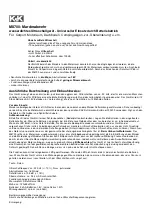
86
/
99
a. OFF: turn off the marker function
b. Auto
Marker source
:
Select spectrum wave as the marker source, which is the spectrum waveform
generated by different detection types under the detecting mode, it can set to real time,
average, maximum hold and minimum hold. Not open trace is gray by default.
Marker count: Set the counts to be marked, the range can set to 1~50.
Marker list
:
Display the information of current marker point, including point number, frequency
and voltage, which can be set to on or off, default state is off.
c. Threshold
Marker source
:
Select spectrum wave as the marker source, which is the spectrum waveform
generated by different detection types under the detecting mode, it can set to real time,
average, maximum hold and minimum hold. Not open trace is gray by default.
Threshold: Set the threshold value to be used as a comparison condition, and mark those
greater than the threshold value and less than the threshold value will not be marked.
Marker list
:
Display the information of current marker point, including point number, frequency
and voltage, which can be set to on or off, default state is off.
d. Manual: use Multipurpose knob to move marker to arbitrary point.
Marker source
:
Select spectrum wave as the marker source, which is the spectrum waveform
generated by different detection types under the detecting mode, it can set to real time,
average, maximum hold and minimum hold. Not open trace is gray by default.
Marker peak
:
Mark the peak value of the current directly.
(8) User’s Presetting
Chang the display mode to full screen by defalut. Other setting remains unchanged.
FFT Operation Tips
Signals with DC components or deviations can cause errors or deviations in the FFT waveform
components.
To reduce the DC component, the channel can be set to AC coupling.
To reduce the random noise and aliasing frequency components of the repetitive or single pulse,
user can set the oscilloscope acquisition mode to average acquisition.
14.3 Logical Operation
(1) Expression
a. AND
:
Performing “AND” logical operation for every point of source 1 and source 2.
b. OR
:
Performing “OR” logical operation for every point of source 1 and source 2.
c.
NOT
:
Performing “NOT” logical operation for every point of source 1, source 2 will not be
displayed at this moment.
d. XOR
:
Performing “XOR” logical operation for every point of source 1 and source 2.
Perform logical operations for all points of the source waveform voltage and display the results.














































